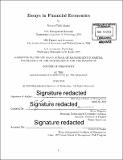| dc.contributor.advisor | Nittai Bergman. | en_US |
| dc.contributor.author | Thakor, Richard Todd | en_US |
| dc.contributor.other | Sloan School of Management. | en_US |
| dc.date.accessioned | 2017-03-20T19:38:36Z | |
| dc.date.available | 2017-03-20T19:38:36Z | |
| dc.date.copyright | 2016 | en_US |
| dc.date.issued | 2016 | en_US |
| dc.identifier.uri | http://hdl.handle.net/1721.1/107530 | |
| dc.description | Thesis: S.M. in Management Research, Massachusetts Institute of Technology, Sloan School of Management, 2016. | en_US |
| dc.description | Cataloged from PDF version of thesis. | en_US |
| dc.description | Includes bibliographical references. | en_US |
| dc.description.abstract | In the first chapter, I examine how financial constraints affect asset allocation, and consequently productivity and asset values. Using a unique dataset of agricultural outcomes, I explore how farmers respond to exogenous cash inflows that are caused by an expansion of hydraulic fracturing (fracking) leases. Farmers who receive positive cash flow shocks increase their purchases of land, which results in a reallocation effect. Examining cross-county purchases, I find that farmers in high-productivity counties who receive cash flow shocks buy farmland in low-productivity counties. In contrast, when farmers in low-productivity counties receive positive cash flow shocks, they do not engage in similar behavior. Moreover, farmers increase their purchases of vacant (undeveloped) land. Average output, productivity, and profits all increase following these positive cash flow shocks, and farmland prices rise significantly. These effects are broadly consistent with an efficient reallocation of land towards more productive users. Finally, I show that farmers borrow relatively less following the cash flow shock. In the second chapter, I develop and empirically test a dynamic sequential equilibrium model of corporate cash payout policy that endogenizes a firm's dividend initiation decision, and its extreme reluctance to subsequently cut dividends in a sequential equilibrium. After payment of dividends, all excess cash is disgorged via stock repurchases that elicit no price reactions. The theoretical model generates results consistent with many stylized facts related to dividend initiations, including: a positive dividend-initiation announcement effect; a larger (in absolute value) negative announcement effect for a dividend cut/omission than for an initiation; and a probability of dividend initiation that is increasing in the firm's profitability and assets in place, and decreasing in the personal tax rate on dividends relative to capital gains. The model also generates additional novel predictions: (i) the probability of dividend initiation is decreasing in managerial ownership of the firm, and this effect is stronger the weaker is (external) corporate governance; (ii) the dividend initiation probability is decreasing in the potential loss in value from the "two-audience-signaling" information disclosure costs associated with secondary equity issues. These new predictions are tested empirically using panel data through a predictive logit model of dividend initiations, and additional empirical support for the information-disclosure result is found using a regression discontinuity design. In the third chapter, I develop a theory in which the owners of firms pursue short-termism in project choice to limit managerial rent-seeking behavior. Unlike in previous theories, a short-term bias in investment horizons maximizes firm value in the second-best case, whereas managers themselves prefer long-horizon projects. Short-termism benefits the firm in two ways: it limits managerial rent extraction by preventing investments in bad projects that delay information revelation about project quality and managerial ability, and it enables faster learning about managerial ability which allows more efficient subsequent decisions. This result does not depend on any stock mispricing or managerial desire to use earnings management in order to manipulate stock prices. The likelihood of short-termism is higher when corporate governance is stronger, and at lower levels of the corporate hierarchy. Numerous testable predictions of the analysis are discussed. | en_US |
| dc.description.statementofresponsibility | by Richard Todd Thakor. | en_US |
| dc.description.tableofcontents | Financial constraints and asset reallocation: evidence from farming and fracking -- The dividend initiation decision: theory and evidence -- A theory of efficient short-termism. | en_US |
| dc.format.extent | 185 pages | en_US |
| dc.language.iso | eng | en_US |
| dc.publisher | Massachusetts Institute of Technology | en_US |
| dc.rights | MIT theses are protected by copyright. They may be viewed, downloaded, or printed from this source but further reproduction or distribution in any format is prohibited without written permission. | en_US |
| dc.rights.uri | http://dspace.mit.edu/handle/1721.1/7582 | en_US |
| dc.subject | Sloan School of Management. | en_US |
| dc.title | Essays in financial economics | en_US |
| dc.type | Thesis | en_US |
| dc.description.degree | S.M. in Management Research | en_US |
| dc.contributor.department | Sloan School of Management | |
| dc.identifier.oclc | 974488676 | en_US |
